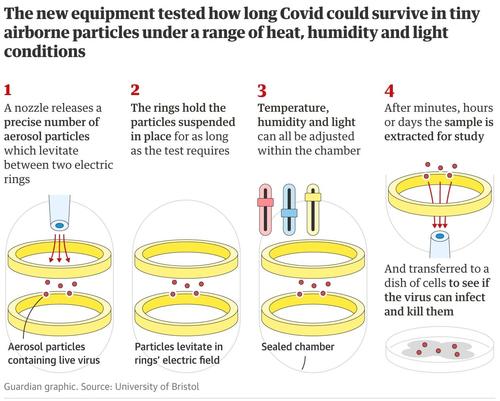COVID’s Ability-To-Infect Plunges 90% After 20 Minutes In The Air; New Study Shows
One recent study found that SARS-CoV-2, the virus that causes COVID and its many variants, actually isn’t as infectious as “the science” – and, more importantly, the government authorities like Dr. Anthony Fauci – would like the public to believe.
Offering yet another example of how lingering in enclosed spaces doesn’t dramatically increase an individual’s risk of contracting COVID, Coronavirus loses 90% of its ability to infect us within 20 minutes of becoming airborne – with most of the loss occurring within the first five minutes, the world’s first simulations of how the virus survives in exhaled air suggest.
Professor Jonathan Reid, director of the University of Bristol’s Aerosol Research Center and the lead author of this study, explained why lingering in poorly ventilated spaces isn’t as risky as scientists would have us believe.
Most of this decline in viral infectiousness was gleaned from a study whose authors described it as the world’s first simulations of how the virus survives in exhaled air suggest.
Interestingly, this means that ventilation, once thought to be the most effective way to ignore the physical distancing and mask-wearing likely to be the most effective means of preventing infection. Ventilation, though still worthwhile, is likely to have a lesser impact.
“People have been focused on poorly ventilated spaces and thinking about airborne transmission over metres or across a room. I’m not saying that doesn’t happen, but I think still the greatest risk of exposure is when you’re close to someone,” Dr. Reid said. “When you move further away, not only is the aerosol diluted down, there’s also less infectious virus because the virus has lost infectivity [as a result of time].”
This latest study completely contradicts previous research conducted by scientists in the US, which purported to show that particles containing the virus that causes COVID could still be found lingering in the air.
Here’s more from the Guardian and Dr. Reid.
Until now, our assumptions about how long the virus survives in tiny airborne droplets have been based on studies that involved spraying virus into sealed vessels called Goldberg drums, which rotate to keep the droplets airborne. Using this method, US researchers found that infectious virus could still be detected after three hours. Yet such experiments do not accurately replicate what happens when we cough or breathe. Instead, researchers from the University of Bristol developed apparatus that allowed them to generate any number of tiny, virus-containing particles and gently levitate them between two electric rings for anywhere between five seconds to 20 minutes, while tightly controlling the temperature, humidity and UV light intensity of their surroundings. “This is the first time anyone has been able to actually simulate what happens to the aerosol during the exhalation process,” Reid said.
Here’s an illustration courtesy of the Guardian purporting to show how the experiment worked.
Source: the Guardian
Another iconoclastic finding from the study: the temperature of the air made no difference to viral infectivity, contradicting the widely held belief that viral transmission is lower at higher temperatures. This would seem to contradict the seasonality of the virus, a pattern that has held for the last two winters.
The study hasn’t yet been peer reviewed, but we imagine scientists will be quick to scrutinize its findings – particularly the findings that contradict the research conducted by other research. – zerohedge.com
article website here
Not sure what to make of this. If it the findings hold up to review true then the four D’s might need to ne rethought. More info leading to the realization that the pandemic is over, or will be soon.
